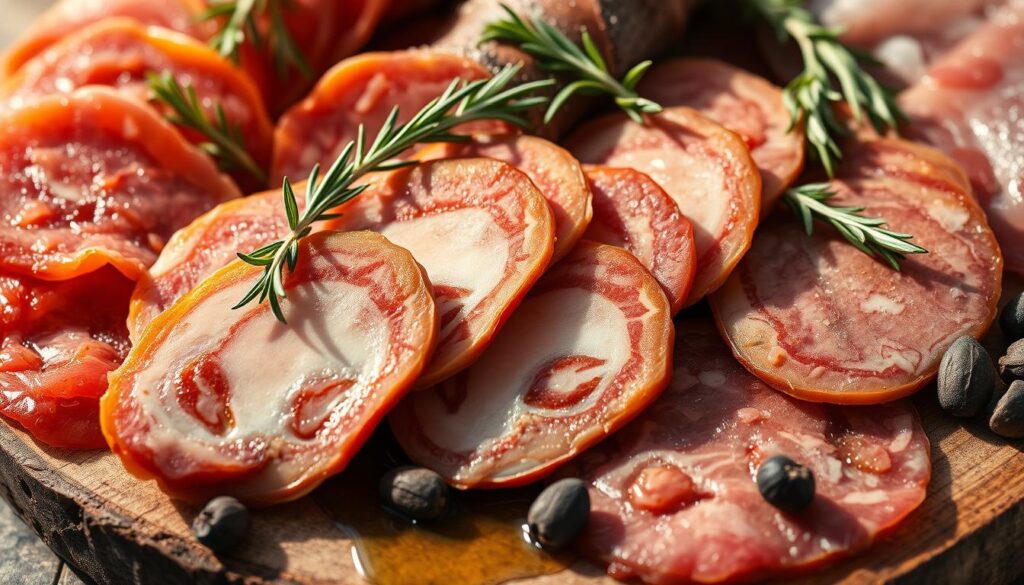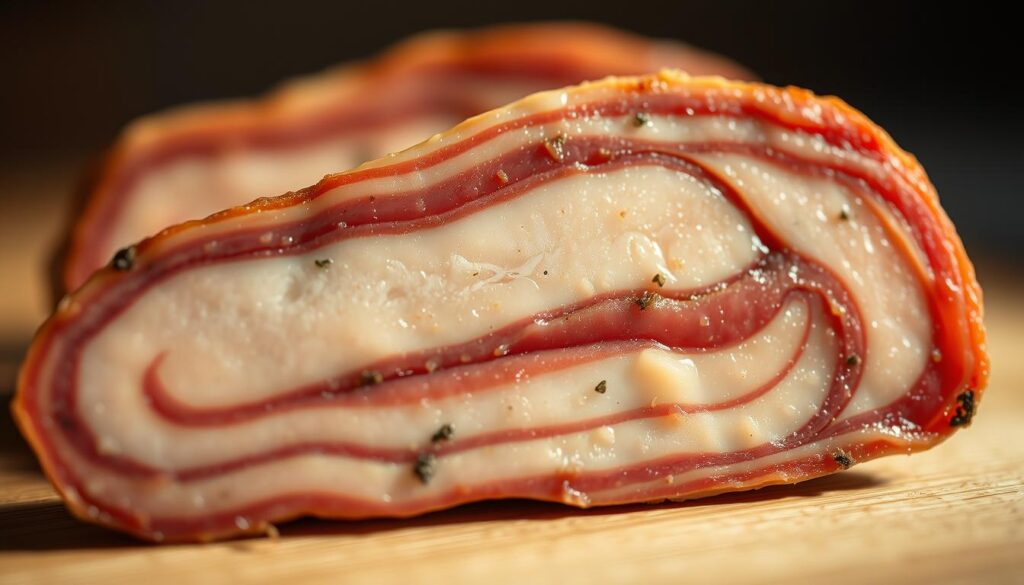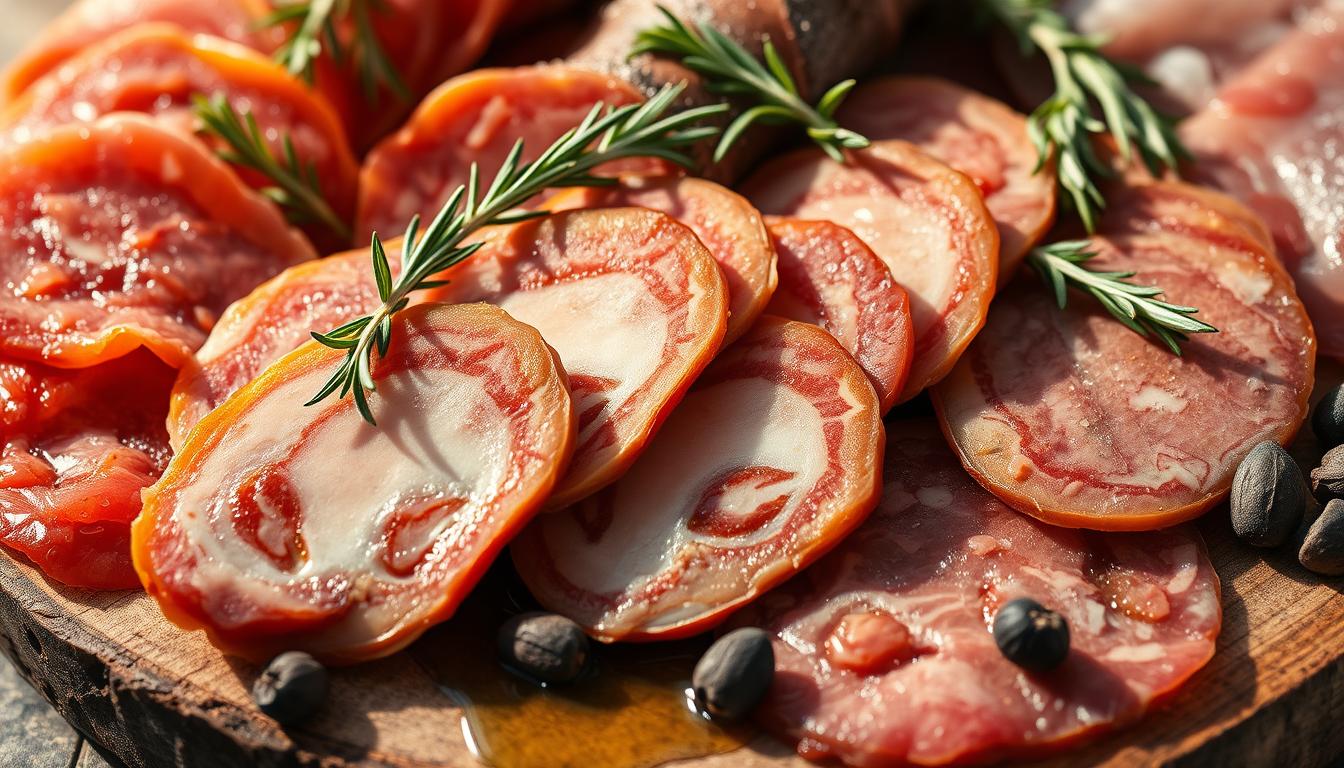Guanciale 101 : Everything You Need to Know
Discover the rich flavors of Italy with guanciale, a cured meat loved worldwide. It’s made from pork jowl, cured with salt and spices. This makes it tender and full of flavor.

Guanciale is a key part of Italian cooking. It’s used to add depth to pasta, pizzas, and salads. Its taste and texture are loved by chefs and food lovers. Learning about guanciale can make your cooking better.
Key Takeaways
- Guanciale is an Italian cured meat made from pork jowl.
- It’s cured with salt and spices, giving it a unique flavor.
- Guanciale is a versatile ingredient used in various Italian dishes.
- It’s a favorite among chefs for its rich, savory taste.
- Understanding guanciale can enhance your cooking and appreciation of Italian cuisine.
What Is Guanciale and Why Is It Special?
Italian food is famous for its cured meats. Guanciale is one of the most loved and wanted. It’s special because of its unique taste and texture.
Definition and Basic Characteristics
Guanciale is a cured meat from the pig’s cheek and neck. It’s known for its rich taste and soft feel. This comes from a special curing process.
The Unique Cut: Understanding Pork Jowl
The pork jowl makes guanciale special. It’s full of fat, making the meat tender and tasty. This is why chefs and food lovers love it.
Guanciale vs. Pancetta vs. Bacon: Key Differences
Guanciale, pancetta, and bacon are all cured meats. But they are different. Guanciale comes from the jowl, not the belly like bacon. It’s air-dried, not smoked.
Pancetta is like bacon but made from the belly. It’s also air-dried. Guanciale has a rich, unsmoked flavor that’s unique.
Guanciale is special because of its cut and how it’s cured. This makes it a favorite in Italian cooking and recipes.
Where Did Guanciale Originate?
Guanciale comes from central Italy’s cooking traditions. It’s been a key part of Italian food for a long time. Especially in rural areas, where pork jowl was easy to get and cheap.
Central Italian Roots
Guanciale’s story is linked to Lazio and Umbria. It was made there traditionally. The curing process, using salt and air-drying, helped keep pork jowl good for eating when food was scarce.
Historical Significance in Rural Communities
In rural Italy, guanciale was more than food. It stood for community and tradition. Making guanciale was a family job, with recipes and methods shared for years.
Evolution into a Culinary Treasure
Guanciale grew from a simple food to a treasured item. Loved for its deep flavor and cultural value. Now, it’s a main part of many Italian dishes and is loved around the world.
How Is Authentic Guanciale Made?
Making real guanciale is an art. It needs the right mix of ingredients and a special curing process. This brings out the best in the pork.
Traditional Ingredients and Seasonings
Guanciale is made with a few top-notch things: pork jowl or cheek, salt, black pepper, and sometimes red pepper flakes or spices. The ingredients list is simple. But the flavor that comes out is complex.
The Curing Process Step-by-Step
The curing of guanciale is careful and takes a lot of time. It starts with picking the freshest pork jowls. Then, they are rubbed with a mix of salt, black pepper, and spices.
The jowls cure for weeks. They are turned and massaged often. This makes sure the cure spreads evenly.
After curing, the jowls get washed to get rid of extra salt. Then, they dry in the air. This step is key for guanciale’s taste and texture.
Regional Variations in Production Methods
Even though guanciale is made the same way all over Italy, there are some differences. Producers might use different spices or cure and dry for different times. These changes make guanciale special in each region.
| Region | Curing Time | Seasonings |
|---|---|---|
| Lazio | 8-10 weeks | Salt, black pepper, red pepper flakes |
| Umbria | 10-12 weeks | Salt, black pepper, garlic |
| Campania | 6-8 weeks | Salt, black pepper, parsley |
These differences show how guanciale can be made in many ways. They also show how local traditions shape the final product.
What Makes Guanciale’s Flavor Profile Unique?
Guanciale’s flavor is special. It has a mix of salt and fat that’s hard to find. This Italian meat makes dishes taste better.
Distinctive Taste and Texture Characteristics
Guanciale’s taste comes from how it’s cured. It’s made with salt and spices. The meat is soft and fatty, making it feel luxurious in your mouth.
Fat Content and Its Culinary Importance
Guanciale has a lot of fat. When it cooks, this fat makes a tasty sauce. This fat is what makes guanciale special, chefs love it.

Why Professional Chefs Prefer Guanciale
Chefs like guanciale because it’s versatile. It’s great in pasta sauces and on pizza. It adds a depth of flavor that’s hard to find.
| Characteristics | Guanciale | Pancetta | Bacon |
|---|---|---|---|
| Curing Process | Salt and spices | Salt, black pepper, and spices | Salt, sugar, and nitrates |
| Fat Content | High | High | Variable |
| Flavor Profile | Rich, savory | Mild, nutty | Smoky, salty |
Which Classic Italian Dishes Require Guanciale?
Guanciale adds a special flavor to many Italian pasta dishes. It’s a key part of Italian cooking, especially in Rome and central Italy.
Authentic Carbonara: Debunking Common Misconceptions
Carbonara is a dish often misunderstood outside Italy. It uses guanciale for its real taste. Unlike creamy versions found elsewhere, true Italian carbonara has guanciale, eggs, parmesan, and black pepper.
Pasta all’Amatriciana: The Traditional Recipe
Pasta all’amatriciana is another Roman dish that shows guanciale’s value. It comes from Amatrice and mixes guanciale with tomatoes, garlic, and Pecorino Romano cheese. This makes a bold yet balanced flavor.
Gricia and Other Lesser-Known Roman Classics
Gricia is a Roman pasta dish that’s not as well-known but just as tasty. It’s made with guanciale, Pecorino Romano, and black pepper. This dish shows the beauty of simple yet deep Italian flavors. Other regional dishes also use guanciale, showing its versatility and rich taste.
Regional Italian Specialties Featuring Guanciale
Guanciale is not just for Roman dishes; it’s used across Italy. It adds flavor to many dishes, from pasta sauces to vegetable dishes. This makes it a must-have in many Italian kitchens.
In short, guanciale is key in many classic Italian dishes. It brings a flavor that’s hard to find with other ingredients. Whether you’re making carbonara, amatriciana, or trying other regional dishes, guanciale will make your cooking better.
How Can You Cook with Guanciale in Everyday Meals?
Guanciale is a special Italian cured meat. It has a rich, unsmoked flavor. Made from the pork jowl or neck, it makes many dishes better.
Proper Preparation Techniques
To enjoy guanciale, prepare it right. Slice it thinly against the grain. This brings out its flavors and textures.
Then, chop or dice it as your recipe needs. When cooking, balance its flavor with other ingredients. For example, spinach or broccoli pairs well.
Rendering the Fat: Tips and Tricks
Guanciale has a lot of fat. You can render it to add flavor to dishes. Heat diced guanciale in a pan over low heat. Let the fat melt and flavor your dish.
Use the rendered fat as a sauce for pasta or a finishing touch for soups and stews. It adds flavor and reduces waste.
Beyond Pasta: Creative Applications
Guanciale is not just for pasta. Use it in salads, as a pizza topping, or in omelets and frittatas. The trick is to mix it with other ingredients to make a balanced dish.
“Guanciale is a versatile ingredient that can elevate a variety of dishes, from classic pasta recipes to innovative salads and breakfast dishes.”
Common Cooking Mistakes to Avoid
When cooking with guanciale, avoid common mistakes. Don’t overcook it, as it becomes tough and loses flavor. Also, don’t forget to balance its richness with other ingredients.
Cook guanciale over low heat. Pair it with ingredients that enhance its flavor. This way, you’ll make delicious dishes that highlight guanciale’s unique taste.
| Dish | Guanciale Usage | Tips |
|---|---|---|
| Pasta Carbonara | Diced guanciale | Balance with eggs and parmesan |
| Salads | Crumbled guanciale | Pair with bitter greens |
| Pizza | Guanciale as topping | Combine with sweet ingredients |
Where Can You Buy High-Quality Guanciale?
Finding the best guanciale can make your dishes better. It’s key for Italian foods like carbonara and amatriciana.
Specialty Italian Markets and Delicatessens
Specialty Italian markets and delicatessens are great for finding real guanciale. They get their products from trusted suppliers and makers of gourmet charcuterie. Look for guanciale made in-house or from local makers.
Reliable Online Sources and Artisanal Producers
You can also buy great guanciale online. Look for artisanal producers’ websites, gourmet food stores, and Italian food platforms. Make sure the seller tells you about the product’s origin and how it’s cured. Some places sell pork cheek bacon, which is another name for guanciale.
What to Look for When Purchasing
When buying guanciale, check a few things. Make sure the ingredients list is simple. It should be firm and have a deep red color. It should smell savory and a bit sweet. Try a small piece before buying more.
Price Expectations and Value Considerations
Guanciale prices vary based on how it’s made, where it’s from, and its quality. You might pay $15 to $30 per pound for top-notch guanciale. Even though it’s pricey, a little goes a long way in your gourmet charcuterie collection.
How Should You Store and Preserve Guanciale?
Guanciale’s flavor and texture need the right storage. Knowing how to store whole pieces and cut parts is key. Also, find out if freezing is a good idea.
Proper Storage Methods for Whole Pieces
Keep whole guanciale in a cool, dry spot. Away from sunlight. Use paper or breathable cloth to wrap it.
This helps prevent mold. Keep your fridge at 32°F to 36°F (0°C to 2°C).
Handling Cut Portions
Cut guanciale gets dry or contaminated fast. Wrap it tightly in plastic or foil. Store in the fridge.
Sealed containers keep humidity in. This stops other tastes from getting in.
Freezing Guidelines: Yes or No?
Freezing guanciale works, but it changes its taste and feel. Freeze for a few months only. Use plastic wrap or freezer paper to avoid freezer burn.
Signs of Spoilage to Watch For
Watch for spoilage signs like bad smell, slimy feel, or mold. If you see these, throw it away.

Can You Make Homemade Guanciale?
Making guanciale from scratch is a fun project. It mixes tradition, skill, and love for food. For those who love to cook, making this traditional Italian bacon at home is rewarding. It lets you enjoy its special flavor and texture more.
Sourcing the Right Cut of Meat
First, find the right meat for homemade guanciale. It’s usually the pork jowl or cheek. This meat is chosen for its fat. The fat makes guanciale taste and feel special.
Essential Equipment and Ingredients
To cure guanciale, you need some basic tools and ingredients. You’ll need kosher salt, black pepper, and sometimes red pepper flakes or spices. A curing mix is key to drying out the meat.
Step-by-Step Home Curing Process
The curing process has a few steps:
- Trim the pork jowl of extra fat.
- Put the curing mix on the meat evenly.
- Let the meat cure for weeks, turning it often.
- After curing, wash the guanciale and let it dry.
- Let the guanciale age to get its special taste.
Food Safety Considerations
When making guanciale at home, follow food safety rules. Use the right curing salts and keep everything clean and controlled. This helps avoid bad contamination.
| Step | Description | Duration |
|---|---|---|
| Curing | Apply curing mixture and let it cure. | 3-4 weeks |
| Aging | Allow the flavors to mature. | 2-3 months |
| Storage | Store in a cool, dry place. | Ongoing |
Conclusion: Embracing Guanciale in Your Culinary Repertoire
Guanciale is a game-changer for anyone who loves to cook. This Italian ingredient adds a deep flavor to many dishes. It’s a must-have in every kitchen.
Guanciale makes traditional Italian dishes like carbonara and amatriciana even better. It also works well in new recipes. Knowing how to use it can take your cooking to the next level.
Guanciale is great for both experienced chefs and home cooks who like to try new things. It adds a rich flavor to many dishes. This makes it a key ingredient for authentic Italian cooking.
Exploring guanciale can make your cooking even better. It’s perfect for adding flavor to pasta and making regional Italian dishes. Using guanciale lets you enjoy the rich traditions of Italian cooking.
FAQ
What is guanciale?
Guanciale is a type of Italian cured meat. It comes from pork jowl. It has a rich flavor and soft texture, great for Italian dishes.
How does guanciale differ from pancetta or bacon?
Guanciale is different from pancetta and bacon. It’s cut from pork jowl and air-dried. It doesn’t get smoked, so it tastes more delicate and unsmoked.
What are the traditional ingredients used to make guanciale?
Real guanciale is made with pork jowl, salt, black pepper, and sometimes red pepper flakes. Some recipes add garlic or herbs too.
Can I make guanciale at home?
Yes, you can make guanciale at home. You need the right meat, tools, and follow a curing process. Make sure to follow food safety rules.
How should I store guanciale?
Store whole guanciale in a cool, dry place. Wrap it in paper or cloth. Cut pieces should be wrapped tightly in plastic or foil in the fridge.
Can I freeze guanciale?
Freezing guanciale is possible but not recommended. It can change the texture and flavor. If you must freeze it, wrap it well to keep quality.
What are some classic Italian dishes that use guanciale?
Guanciale is key in Italian dishes like carbonara and pasta all’Amatriciana. It’s also in gricia and other regional dishes, showing its rich taste.
How do I cook with guanciale?
Slice guanciale thinly and cook its fat in a pan. Then, use it to add flavor to pasta, soups, and sauces.
Where can I buy high-quality guanciale?
Find top-notch guanciale at Italian markets, delicatessens, and online. Look for artisanal producers for the best gourmet charcuterie.
What should I look for when purchasing guanciale?
Choose guanciale made from quality pork jowl. It should have the right fat and lean meat balance. Look for aging to get the best flavor and texture.




